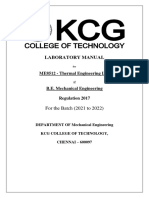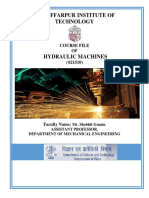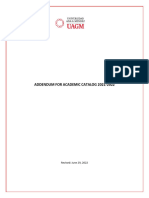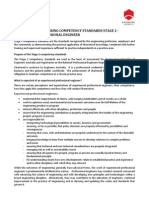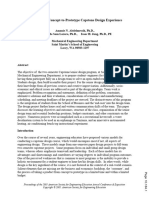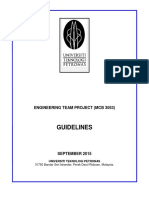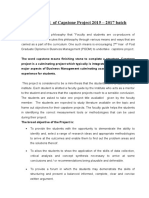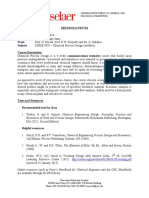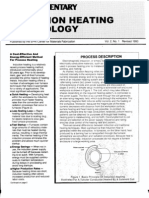B48BE Student Guide v2
B48BE Student Guide v2
Uploaded by
Farid AliyevCopyright:
Available Formats
B48BE Student Guide v2
B48BE Student Guide v2
Uploaded by
Farid AliyevCopyright
Available Formats
Share this document
Did you find this document useful?
Is this content inappropriate?
Copyright:
Available Formats
B48BE Student Guide v2
B48BE Student Guide v2
Uploaded by
Farid AliyevCopyright:
Available Formats
1
Process Design A: Student Guide
B48BE Process Design A
Year 2 Process Design Project
Student Guide
CRP:
John Andresen
Heriot-Watt University
Edinburgh EH14 4AS, United Kingdom
Produced by Heriot-Watt University, 2015
HERIOT-W ATT UNIVERSITY
B48BE
October 2015 v2
Process Design A: Student Guide
Copyright 2015 Heriot-Watt University
All rights reserved. No part of this publication may be reproduced,
stored in a retrieval system or transmitted in any form or by any means
without express permission from the publisher.
This material is prepared to support the degree programmes in
Chemical and Petroleum Engineering.
Distributed by Heriot-Watt University
Chemical Engineering
HERIOT-W ATT UNIVERSITY
B48BE
October 2015 v2
Process Design A: Student Guide
Acknowledgements
Thanks are due to the members of Heriot-Watt, School of Engineering and Physical
Science who planned and generated this material.
We would like to acknowledge the assistance and contributions from colleagues
across the University and candidates in preparing this and support material.
HERIOT-W ATT UNIVERSITY
B48BE
October 2015 v2
Process Design A: Student Guide
B48BE Process Design A
Student Guide
Contents
PREFACE ................................................................................................................................ 6
1 PROJECT OVERVIEW ............................................................................................................ 7
2 COURSEWORK COMPONENTS ............................................................................................... 8
3 TIMETABLED HOURS ............................................................................................................. 8
4 PROJECT ELEMENTS .......................................................................................................... 10
4.1 CRITICAL ELEMENTS ........................................................................................................ 11
4.1.1 Development of Flow Diagram Task 1 ............................................................ 11
4.1.2 Material & Energy Balance Table Task 2 ........................................................ 12
4.1.3 Pump and Pipeline Specification Task 3 ......................................................... 13
4.1.4 Heat Exchanger Sizing Task 4 ....................................................................... 14
4.1.5 Safety, P&ID and Environmental Task 5 ......................................................... 14
4.1.8 Group Presentations Task 6 ........................................................................... 15
4.1.9 Written Report Task 7..................................................................................... 15
4.1.10 General Considerations ................................................................................... 15
5 DEADLINES FOR TASK SUBMISSION: .................................................................................... 17
6 MARKING SCHEME FOR WRITTEN REPORT ........................................................................... 18
7 REPORT FORMAT ............................................................................................................... 20
8 INFORMATION RESOURCES.................................................................................................. 22
9 PEER REVIEW MARKING SCHEME ........................................................................................ 23
9.1 DESIGN UNDERSTANDING AND CONTENT .......................................................................... 23
9.2 CLARITY ......................................................................................................................... 24
10 BIBLIOGRAPHY ................................................................................................................. 25
Prerequisite knowledge
Process Industries C.
Process Engineering A Fluid Mechanics.
Process Engineering C Heat Transfer. Although Process Engineering
C is a Y2, S2 course many of the heat exchanger design elements
should be well underway and provide good synergy for both courses.
Learning objectives
After completing this course you should be able to:
Work on open-ended design exercise and learn how to tackle problems
that have several solutions.
Apply knowledge gained from other courses to prepare overall process
flowsheets and heat and material balance tables.
HERIOT-W ATT UNIVERSITY
B48BE
October 2015 v2
Process Design A: Student Guide
Apply knowledge gained from other courses to design individual items
of equipment such as pipelines, pumps and heat exchangers.
Develop important time management skills, how to work in groups and
how to meet both group and individual project deadlines.
Develop research and technical report writing skills.
Develop personal initiative and the ability to find, sift, sort and assess
information and data from many different sources.
Experience delivering a project brief to a group that evaluate both the
merits of the design itself, as well as the strategy adopted to tackle the
overall design problem.
HERIOT-W ATT UNIVERSITY
B48BE
October 2015 v2
Process Design A: Student Guide
Preface
The characteristics of engineering graduates
The creative way of approaching all engineering challenges is being seen
increasingly as a 'way of thinking' which is generic across all engineering
disciplines. In order to operate effectively, engineering graduates thus need to
possess the following characteristics. They will:
Be pragmatic, taking a systematic approach and the logical and
practical steps necessary for, often complex, concepts to become
reality.
Seek to achieve sustainable solutions to problems and have strategies
for being creative, innovative and overcoming difficulties by employing
their skills, knowledge and understanding in a flexible manner.
Be skilled at solving problems by applying their numerical,
computational, analytical and technical skills, using appropriate tools.
Be risk, cost and value-conscious, and aware of their social, cultural,
environmental, health and safety, and wider professional
responsibilities.
Be familiar with the nature of business and enterprise in the creation of
economic and social value.
Appreciate the global dimensions of engineering, commerce and
communication.
Be able to formulate and operate within appropriate codes of conduct,
when faced with an ethical issue.
Be professional in their outlook, capable of team working, effective
communicators, and able to exercise responsibility and sound
management approaches.
(QAA Subject Benchmark Statement, 2014)
HERIOT-W ATT UNIVERSITY
B48BE
October 2015 v2
Process Design A: Student Guide
1 Project Overview
An engineer has to be able to work with unfamiliar data, work in a team
environment and solve new problems that rely on decision-making and
judgement, often with little initial data, while working to tight deadlines.
Projects like this allow students to develop the following skills: demonstrate
their understanding of core material; source information from technical
publications; make sensible assumptions; work individually and in groups;
present findings in a clear and concise way using technical language, both in
the form of a written report and as a verbal presentation before other groups.
Courses which contain core material from the first half of the Chemical
Engineering MEng/BEng degree programme are listed below. The critical
tasks that must be completed (see later) are associated with the core material
as follows:
Process Industries A & B
Process Industries
C
Process Engineering A
Process Engineering B
Process Engineering C
- Material Balances/Units
- Material Balances/Units
- Fluid Mechanics/Pumps
- Thermodynamics
- Heat Transfer
- Tasks 1, 2 & 5
- Tasks 1 & 2
- Task 3
- Task 1 & 2
- Task 4
It should be noted that students will still be studying Thermodynamics and
Heat Transfer in semester 2 this is unavoidable and normal.
The way the tasks are organised deals with this problem. Tasks 1 and 2
(weeks 2 & 4 deadline) involves material from Process Industries A, B and C
(these modules were completed earlier in the course. Task 3 (week 6
deadline) involves material from Process Engineering A and this too has
already been completed in semester Y2/S1. Task 4 (week 8) deadline does
overlap with Process Engineering C teaching.
By the time task 4 is started (week 6) the lecturer will be well into the design of
heat exchangers. In many ways the design project helps students (in class)
focus on what is important, ask questions and sift relevant details from the
lecture material. Students will find that this focus and discussion will both
assist with the project, as well as improve their grades in Heat Transfer. The
lecturer will also be in place to assist students whenever possible and will
enjoy the generally enhanced teaching environment and debate.
The projects undertaken will involve a knowledge of material and energy
balances, heat exchange, heat loss, fluid transportation (both pumping &
compression), heat effects of combustion (or phase change or mixing)and
physical property estimation; such as density, specific heat capacity and
enthalpy.
HERIOT-W ATT UNIVERSITY
B48BE
October 2015 v2
Process Design A: Student Guide
In addition to the material listed above, Process Design A will also require the
following: the development of spreadsheets; the completion of line drawings
and flow diagrams; the use of strength of materials to determine the thickness
of process equipment; safety and process hazard assessments.
2 Coursework Components
The overall course mark breaks down into three component parts as follows:
65% is allocated to the written report. These reports must be finalised
and submitted in good time for marking. The reports will be distributed
to available academic staff for marking.
5% is allocated to the presentations, which will be both peer-reviewed
and moderated by the course leader.
30% is allocated to two VB-programing assignments for more details
see separate Process Design Modelling Student Guide.
The VB-programing element may be carried out by the course leader
themselves, or by another member of staff with more specialist knowledge in
this area. VB-programing will involve both the use of Excel spreadsheets and
Visual Basic coding embedded within Excel.
The lecturer managing the Visual Basic component will mark the element in
conjunction with guidance posted on Vision. Students should request this
information from the lecturer.
3 Timetabled Hours
Four timetabled one-hour slots will be allocated. Two classes are formal
classes supervised by the course leader and assistants.
These two classes will be organised as a double class. The first hour is a
lecture slot covering background information relevant to each task, plus some
revision material which relies on previous courses.
The follow-on hour provides space for discussion with the course leader and
assistants. Each group will be allocated a slot in which they must present how
the task has progressed and then take guidance from the course leader. This
is called the task reporting session.
The four timetabled timeslots are organised as follows:
Formal class:
One hour
Task reporting
One follow-on hour
Group time:
One hour
Group time
One hour
HERIOT-W ATT UNIVERSITY
B48BE
Supervised
Supervised
Unsupervised
Unsupervised
October 2015 v2
Process Design A: Student Guide
During the second follow-on hour the course leader will guide the group and
act as gate-keeper with the aim of encouraging the group to revise their
findings and enabling the group to progress to the next task.
Before the task reporting session, the group will select one group members
task, review it before the meeting and choose a group member to present the
task findings. Group members must take it in turn to present the task findings
each week.
The course leader will provide feedback and direction for the benefit of the
group. The feedback will be formative this is not a summative assessment
and does not affect the marks. It is a purely formative assessment and
guidance session from the course leader.
The two hours later in the week are unsupervised, but are timetabled so that
your group will have a classroom in which you can meet, work on the project
and interact with other groups.
After the task reporting meeting, students will often have to take on-board the
lecturers comments and this will often mean revising and reviewing group
and/or individual contributions.
The flow and structure of the lecture material is designed to complement the
schedule of tasks (this will be evident later when deadlines are discussed in
section 5), in the meantime the lecture slot will roll out as follows;
Week
Number
1
2
3
4
Lecture Material
Week 1a & 1b:
Introduction
Eng. diagrams
Week 2:
Unknowns MB table
Week 3:
Mass Balances
Week 4:
Energy Balances
Spec. Sheets
Week 5:
Mech. Eng. For
design
Week 6:
Heat
Exchanger
design.
Week 7:
Design Report
HERIOT-W ATT UNIVERSITY
B48BE
October 2015 v2
10
Process Design A: Student Guide
8
9
10
11
12
Week 8:
Industrial Visit
Week 9:
Presentation skills
None
None
None
In weeks 10, 11 and 12 some lecture slots are free and this is to assist student
in the preparation and delivery of oral presentations and the final written
report. These are the two summative assessment elements of the design
project and together account for 70% of the overall mark the VB Programing
component accounts for the remaining 30% of the overall mark.
Groups will be selected as far as is possible on the basis of mixed ability.
The course leader has all the year one marks available and will seed the
groups in such a way that it is unlikely for strong and weak groups to
emerge. If in any doubts students are encouraged to ask the course leader
how this was done.
4 Project Elements
During the first lecture, your group will be allocated a project brief describing
the plant that you are required to design
To help with time management, the project is divided into a number of tasks or
elements. At the end of each task, the design group is expected to make a
presentation to the course leader before moving on to the next task.
After the presentation, the course lecture or an assistant will often provide
advice in order to help groups overcome obstacles and to assist with
decisions-making.
Some tasks are assessed as part of the group. Other tasks must be carried
out and executed individually. However, the bulk of the marks are allocated on
the basis of individual effort.
The group tasks involve a large initial undertaking and it is important that the
overall workload is shared out equitably between available group members. It
is important to finish the flow diagram and mass and energy balance tasks on
time, otherwise time will be tight for the individual tasks.
It will be seen below that time management is critical to the roll out of the
project. Each group must prepare a Gantt chart using Microsoft Project and
present this to the course leader at the beginning of the design project.
HERIOT-W ATT UNIVERSITY
B48BE
October 2015 v2
11
Process Design A: Student Guide
4.1 Critical Elements
The critical elements that must appear in the final report are listed below, tasks
1, 2 and 5 are group tasks and each individual is allocated the same group
mark for these sections.
Each task is described below, followed by the hand-up deadlines for each task
and then the weightings that apply. Remember, the hand-up deadlines must
be viewed as targets. Any slippage can be penalised and these
arrangements will be communicated by the course leader.
4.1.1 Development of Flow Diagram Task 1
Task 1 is a group task and the group must pull together and work hard to get
this critical item completed on time. The course leader has to agree to the
submission before the group can progress. The course leader will sign-off
once this task is complete. However, this does not imply that everything is
correct, merely that there is enough detail and consistency in the drawing for
the design process to proceed.
The purpose of the first task is to daw a flow diagram of the overall plant
showing all major process and ancillary equipment, as well as plant operating
conditions. To reach the point of an acceptable flow diagram, your group must
first research the process and find typical schemes. The starting point will be a
block diagram which will then develop into a properly structured flow diagram.
Once a scheme is identified, it must be re-drawn using PowerPoint or Visio
and any modifications to the original scheme should be clearly identified. A
clear written interpretation and explanation of a flow diagram is also expected.
It is important to identify the following: all operating conditions, in particular
temperatures, pressures; identify all compositions and phases present; identify
all the components, materials, and compounds taking part in the process; and
estimate the physical properties of streams under operating conditions.
The Flow Diagram equipment and stream numbering has to be agreed, so that
a finalised flow-sheet may be produced as early as possible; otherwise
completion of task 2 will be compromised.
HERIOT-W ATT UNIVERSITY
B48BE
October 2015 v2
12
Process Design A: Student Guide
4.1.2 Material & Energy Balance Table Task 2
Task 2 is again a group task and is a very challenging part of the project. The
course leader will again sign-off once this task is complete. However, this
does not imply that everything is correct, merely that there is enough detail
and consistency in the material and energy balance table for the design to
progress onto the individual tasks.
A material and energy balance table must be submitted by the group along
with all stream properties, component flows, stream temperatures and
pressure.
All calculations should be neatly laid out in the body of the report. Of particular
importance is the calculation of stream mixture properties, such as enthalpy,
heat capacity, density, viscosity and thermal conductivity. These should also
be summarised in a stream property table.
Other calculations that will be needed include: stoichiometric and
thermodynamic calculations (relative to chosen basis); estimates of heats of
reaction; identification of any phase changes.
The energy balance will include the enthalpies of all streams, the temperature
and pressure of all streams and any heat or work effects associated with all
major equipment items.
These heat and work effects include: heating and cooling loads for all heat
exchangers; pump and compressor power requirements (throughout the
plant). It is also important to identify likely heat recovery sources as well as all
other energy transactions, such as reactor cooling/heating loads.
Major assumptions will be needed around Unit Operations for instance, what
weight fraction of solids it is sensible to remove in a filter press, or what sort of
recovery is expected in top and bottom products leaving a distillation column.
The amount of work needed to find stream properties revolves around
identifying the major component in the stream so that appropriate simplifying
assumptions may be made. Please note that you are not designing Unit
Operations at stage 2.
Before the course leader signs-off on this work, there must be sufficient
equipment items for all group members. It is usual for the course leader to add
additional heat exchangers and pumps. The flow diagram must then be
updated with these changes.
All of these tasks are most efficiently laid out in Excel work sheets, evidence of
these should be shown to the course leader and presented in the final written
documentation.
HERIOT-W ATT UNIVERSITY
B48BE
October 2015 v2
13
Process Design A: Student Guide
These calculations will be time consuming and it is important to divide up the
work fairly between group members; keeping in good communication with
team members, so that calculations are correct and uniform is equally
important.
4.1.3 Pump and Pipeline Specification Task 3
Task 3 is the first individual task and it should be started when the group has
agreed on and a reasonable heat and mass balance table is available.
The group will assign each individual group member a section of plant and the
group member is required to size the pipe diameter and length, specify its wall
thickness and present an isometric layout drawing of the pump, pipework,
valves and fittings that link this particular section of plant together.
The 3-D location of the processing units together with all pipework, valves and
fittings should all be specified on an isometric drawing; this will allow more
realistic estimates of pressure drop, pump sizing, pump selection and pump
power input.
Once realistic pressure drop calculations have been completed, the pump
must then be sized and a final pump selection should be made using
published pump curves. Pump power requirement and efficiency calculations
need to be presented in this section of the report.
Individual group members will be asked to design a pump or a compressor but
not both. If a compressor is being designed then exhaust gas temperature and
power requirement will also be needed.
For multi-stage compression use one of the following techniques: the nmethod, to determine the number of compression stages and other key
parameters; a pressure-enthalpy chart to plot out the stages of compression
for a pure component.
Again, all of these tasks are most efficiently laid out in Excel work sheets
evidence of these should be shown to the course leader and presented in the
final written documentation.
The completed task, together with one specification sheet per group, should
be submitted to the course leader immediately after the lecture slot. For the
benefit of the group, the course leader will comment on the sheet but not mark
it; remember task reporting sessions are formative assessment not
summative assessments.
HERIOT-W ATT UNIVERSITY
B48BE
October 2015 v2
14
Process Design A: Student Guide
4.1.4 Heat Exchanger Sizing Task 4
Task 4 is generally started after task 3 but, due to the need to revise earlier
work, it is unlikely that one task will be completely finalised before the next is
started. Course leaders understand this and students should appreciate that
they will usually need to work on some tasks in parallel.
Again, this task involves individual group members working on their part of the
plant. However, group members should pick one design specification sheet
and should come together and present this at the task reporting session. Over
the semester this work should be shared fairly between group members.
Each individual group member is required to design a heat exchanger to the
level of detail needed to complete the design specification sheet. Remember,
there are many types of heat exchanger and heat exchanger selection critically
depends on application. The selection of heat exchanger type is a very
important element of the overall heat exchanger design task.
The calculations should involve individual film and overall heat transfer
coefficients and should include a realistic allowance for fouling. These
calculations must clearly demonstrate that both thermal and hydraulic design
criteria have been applied.
All of these tasks are most efficiently laid out in Excel work sheets and
evidence of these should be shown to the course leader and presented in the
final written documentation.
The completed task should be submitted to the course leader immediately
after the lecture slot. For the benefit of the group, the course leader will
comment on the sheet but not mark it; remember task reporting sessions are
formative assessment not summative assessments.
4.1.5 Safety, P&ID and Environmental Task 5
Task 5 is once again a group task. It is completed by the group and included in
the common part of the written report.
The group must clearly identify and summarise the chemical hazards
associated with the process as a whole. This does not simply mean providing
a copy of the MSDS (Material Safety Data Sheet) for each chemical.
The group should show an appreciation of how the information from an MSDS
sheet may be used in the event of a leak. Any such leak will lead to the
release of chemicals into the immediate working environment.
HERIOT-W ATT UNIVERSITY
B48BE
October 2015 v2
15
Process Design A: Student Guide
A rudimentary P&ID should be included with each individual section of the
plant and demonstrates that you have a rudimentary grasp of where to position
the valves as well as what basic measurements are needed.
A one page summary of the environmental features of the process should be
submitted, including raw material acquisition and waste disposal.
It should be understood that the scope of this task should be considered in
relation to the time allocated to the task (only one week is allocated) and timemanagement decisions need to be taken to keep the project on-course.
Remember, only one week is allocated to this task and only 5% of the marks
are assigned to it.
On completion of this task, there is an opportunity to discuss any loose-ends
and to review the requirements for project write-up and presentations. Make
sure that parameter inputs to a particular section match parameter outputs
from the previous section and that these parameters are also aligned with the
process overview (see section 8 later).
4.1.8 Group Presentations Task 6
Task 6 is the group presentation and these are split over two weeks. Your
group will be required to present in one week and provide peer assessment
that week. A schedule of group presentations will be issued before the tasks
have to be delivered.
4.1.9 Written Report Task 7
Task 7 is the submission of the final written report. Once again this may turn
into a time management problem. However, if the previous tasks have been
organised systematically, then the project write-up should come down to a
simple compilation of tasks (for the various sections), formatting and layout.
4.1.10 General Considerations
The above list of critical elements requires candidates to demonstrate a good
working knowledge (and competence) in the following areas:
Preparation of block diagrams and flow diagrams.
Preparation of material and energy balance tables in conjunction with a
good flow diagram.
Design of a pressure vessel limited to metal thickness calculations.
Design an item of heat transfer equipment.
Design of vessels, connecting pipelines and fluid conveying equipment
(either a pump or a compressor).
HERIOT-W ATT UNIVERSITY
B48BE
October 2015 v2
16
Process Design A: Student Guide
Location of essential valves and basic measuring devices and
preparation of a first-look P&ID.
Identification and assessment of process hazards.
Each group should submit a single bound report and upload an electronic
version of the report, spreadsheets, viso drawings and scans of key charts and
diagrams to Vision.
Guidelines on what should appear in the design reports are given during the
lectures. These run in parallel with the design task review sessions. All
calculations must show evidence that units have been checked.
Sources of data, such as physical properties must be available in
spreadsheets and must show clear referencing. Datasheets for each item of
process equipment should also be contained in the report.
It is important that each member of the group is exposed to the entire breadth
of the topics and activities listed above. The actual depth undertaken must be
carefully considered as a time management problem.
For this particular design exercise, the work should be viewed as a
preliminary design. This means simply the first iteration in the design of a
chemical engineering process. It is not meant to be at the same level of detail
that would be expected from an individual that is about to graduate.
It must also be appreciated that any design is an open ended exercise. There
may be no single solution. The problem may not have appeared before. The
design project is not simply an exercise in browsing the web and looking for
similar processes.
Individual group members need to approach the work in a professional manner
and that means marshalling all available expertise. Above all it means
enterprise and initiative.
The phrase I couldnt find anything is not an option. Non-attendance or
lateness, when group meetings have been organised, are both unprofessional.
It cannot be stressed enough that the students approach to the project should
be proactive otherwise tight deadlines will not be met. At all stages of the
project, good team spirit and collective responsibility are also essential
ingredients.
HERIOT-W ATT UNIVERSITY
B48BE
October 2015 v2
17
Process Design A: Student Guide
5 Deadlines for Task Submission:
The deadlines for tasks 1-5 below are target deadlines to help groups manage
their time. It is usual that deadlines are not met exactly as stated. It is then
important to work on tasks in parallel in order to get the project back on
course.
Week
Number
1
Task Number Task
Submitted
Description
Task 1
3
4
Task 2
Task 3
7
8
Task 4
Task 5
10
11
12
Task 6
Task 6
Task 7
Lecture Material
Week 1a & 1b:
Introduction
Eng. diagrams
Flow Diagram
Week 2:
Unknowns MB table
Week 3:
Mass Balances
Heat
&
Mass Week 4:
Balance
Energy Balances
Spec. Sheets
Week 5:
Mech. Eng. For
design
Pipeline & Pump
Week 6:
Heat
Exchanger
design.
Week 7:
Design Report
Heat Exchanger
Week 8:
Industrial Visit
Safety, P&ID & Week 9:
Environmental
Presentation skills
Presentations - 1
None
Presentations - 2
None
Written Report
None
Task submission hand-ups for tasks 1 5 are mid-week (during the task
reporting session).
Task 6 will be organised during the two supervised timetabled hours in weeks
10 and 11 and some preparation of slides will be possible in any free
timetabled slots.
The presentations will be peer-reviewed and all peer-reviewing groups must
attend these presentations. The peer review form should be completed and
submitted in class.
Task 7 submission date and time is end of business, Friday, week 12.
HERIOT-W ATT UNIVERSITY
B48BE
October 2015 v2
18
Process Design A: Student Guide
6 Marking Scheme for Written Report
Extracts from a spreadsheet, which assists lecturing staff in the marking of
final written submissions is given below. It shows the weightings that apply and
how the tasks fit into this weighting scheme:
Section
Introduction/main
section (group
mark)
Individual
Designs
Detail
Flowsheet/block diagram
should be logical and clear
Mass Balance should be
consistent and sensible.
Energy Balance should be
consistent and sensible.
Environmental impacts
discussed.
Safety hazards identified
Limitations appreciated.
1. Understanding of
Layout/practical
considerations and overview
of individual section, i.e.
Material and energy balance
calculations, flow diagrams
and reference to process
descriptions.
2. Pump/compressor and pipe
design calculations are
sensible and follows logical
methodology.
3. Heat exchanger or similar
heat transfer equipment
design calculations are
sensible and logical.
References made to handling
temperature effects.
4. Selection of material,
mechanical strength and
design stress calculations at
right conditions.
5. Understanding of valves
and measurement.
Rudimentary P&ID should be
clear, correct, use standard
notation and document any
(sensible) departures from
standards.
HERIOT-W ATT UNIVERSITY
B48BE
Weight
20%
Tasks
1, 2 & 5
10%
3&4
20%
30%
5%
3&4
5%
October 2015 v2
19
Process Design A: Student Guide
Section
Report and
Calculations
(group mark)
Detail
Report clear, concise and free
from errors. Consistent
referencing style used. Clear
calculations. Sensible use of
rounding. Correct use of units.
Weight
10%
Tasks
ALL
Notice that the Group Mark (worth 30% overall) is the same for all team
member also the mark covers not only tasks 1, 2, 5 but also the final group
report (the final group report effectively covers all tasks).
Item 1 of the Individual Design (worth 10%) is an overview of how well
individuals have taken the overall plant, broken it down into an individual
section, laid out individual flow diagram and summarised relevant heat and
mass balances that apply to their section of the plant.
Item 3 of the Individual Design (worth 30%) is the heat exchanger (task 4).
The weighting for element is quite high, since this involves more effort. For this
reason sufficient time must be allocated to this part so that it may be
completed to the expected standard.
The same general comments apply to the weighting of Item 2 of the Individual
Design which is the pipeline, pump, compressor design section (task 3). The
weighting is high, 20%, to reflect the amount of effort expected.
Items 4 and 5 of the Individual Design section (task 3, 4 & 5) carry a lower
the weighting and this reflects the lower output and effort expected. Individuals
should manage the time devoted to these tasks in comparison to the time
devoted to the heat exchanger and pump/compressor/pipe tasks.
If an individual fails to submit a task, or fails to present in task 6, then this will
attract a zero mark. If the particular task weighting is high, then this may have
a serious effect on the individuals overall grade.
One of the major objectives of Process Design A is managing time. Paying
attention to weightings is one way to estimate the time and effort needed to
complete all the tasks on time.
Design is an iterative process and there is only sufficient time for a very rough
first iteration. Reasonable assumptions regarding any missing data should be
attempted before coming to group meetings and task-reporting sessions.
It is clear from all that has been said that tasks 1 and 2 are very important and
groups would be well-advised to hit the ground running from week 1 of the course.
Falling behind at this early stage will have serious consequences.
HERIOT-W ATT UNIVERSITY
B48BE
October 2015 v2
20
Process Design A: Student Guide
The mark for the report is worth 65%, the presentation is worth 5% and the VBprograming is worth 30% of the overall coursework mark.
7 Report Format
It is highly recommended that the group submit a single report which includes
the work of all individuals. The final format of the report should be discussed
with the design project instructor.
The report format will be outlined in the briefing lectures, but broadly speaking
the following format is expected.
1. Introduction
General introduction to report, contents list, identification of individual sections.
2. Process Overview
Process overview, with block diagram and flowsheet, together with key facts
about unit operations and operating conditions. This must be written in a style
that convinces the reader that the group understands how the process works
and why each processing step is needed.
Overview of the process material and energy balance tables. The material and
energy balance calculations must be well laid out and tables must be complete
with key property values. A neat well-drawn flowsheet must accompany the
material and energy balance tables with clearly numbered streams.
A summary of the how the physical properties were found and any critical
limitations that may apply to the technical section.
A summary of safety and environmental impacts, showing what general
precautions are required. A demonstration that the group understands the
hazards attached both to the process itself and the chemicals being handled
and stored.
A flow diagram of the entire processing scheme, with key units (pumps, heat
exchangers, compressors) that individual group members have designed,
clearly identified and assigned to the relevant individual.
HERIOT-W ATT UNIVERSITY
B48BE
October 2015 v2
21
Process Design A: Student Guide
3. Individual Technical Sections
Each group member will include in the report their own contribution. Each will
have the format:
Introduction and discussion of the scope of the individual section,
including a small material and energy balance around the equipment
items.
A description of the processing step and key design assumptions
A flow diagram of the individual plant items.
Physical properties used for each stream should be clearly presented
with references.
Pipeline, pressure loss and pump sizing also required is pump
selection. Layout including an isometric drawing.
Mechanical calculations, wall thickness and corrosion allowance.
Materials property selection justification.
Heat exchanger sizing and design including layout.
Equipment specification sheets, comments and recommendations
should be supplied.
Theory and calculations should be shown in sufficient detail. Proper
use of units is encouraged at all stages.
Analysis of safety and hazards for this process section/equipment
items.
Rudimentary P&ID instrumentation listing and positioning.
A reference list must be included using the Harvard Referencing
Scheme.
4.Summary and Conclusions
A list of recommendations arising from the study including a summary of
overall sizes, power required, heat exchange area and any reflections on the
exercise (from a technical point of view); of importance here is a realistic
technical assessment of all critical assumptions.
The font should be Arial 12 pt. with lines single-spaced. The report should be
A4 and double-sided. Default Word margins and normal spacing from the
toolbar.
Headings level 2 and 3 should be used. Heading level 1 is reserved for the title
of the report. Final electronic copies should be uploaded to Vision.
HERIOT-W ATT UNIVERSITY
B48BE
October 2015 v2
22
Process Design A: Student Guide
8 Information resources
Try and make best use of all the resources in the library. There are a number
of general starting points such as textbooks that may be specific to your
design. Other general information sources are the technical encyclopaedias
such as:
Kirk Othmer
McKetta
Also try and make best use of technical journals such as:
The Chemical Engineer: the I.Chem.E. publication which may give
recent trends and ideas.
Chemical Engineering: an American publication which, like TCE gives
general information on a whole range of topics from full plants to
specific items of processing equipment, such as pumps, filters etc.
Hydrocarbon Processing: a very useful publication, which often has
special editions outlining flow diagrams of major process plants.
Note that these paper-based sources in the library may be several years old,
but the basic techniques and science has not changed. It would be wise to
start here before spending hours typing key-word searches into Google.
For technical data, physical properties, constants as well as basic information
on how things work, it would be wise to identify standard design-type text
books. Some of the information will be unfamiliar and some too advanced for
2nd year but they are worth browsing through:
Perrys Chemical engineers Handbook: a central book for data and
points to way to other information/data sources.
Coulson & Richardson Vol 6: known as the book donated by industry.
This is a very good general text and does an excellent job in terms of
summarising certain design-type calculations. However, final year
students are advised to treat this with care and not be too formulaic;
C&R does not cover all equipment and design procedures.
Backhurst & Harker Process Plant Design: a very good concise text.
Kern, Process Heat Transfer: possibly the key book for information on
heat transfer, albeit somewhat dated at this stage.
Smith & McCabe Unit Operations: again, a good general text but one
that covers more unit operations in greater depth than will have been
covered in class by year 2.
Be aware that different texts tend to use different symbols and a whole range
of units. This course emphasises that units and unit conversion is an important
skill and this design project will serve to confirm this fact.
HERIOT-W ATT UNIVERSITY
B48BE
October 2015 v2
23
Process Design A: Student Guide
9 Peer Review Marking Scheme
A grading sheet for project presentations, like the one below, will be handed
out to the grading students:
The presentation is worth 5% of the overall project mark.
Each student grades each presentation in accordance with scheme
below.
The mark assigned is 50% of the average class mark and 50% of the
course leaders mark.
Group number and topic:
Total Score:
__
9.1 Design Understanding and Content
Score:
of 70
This mark is based on the demonstrated knowledge of the main topic area and
an ability to show understanding of the key steps towards a design:
Introduction to problem (5 pts)
Process description using flow diagram (10 pts)
Main material and energy balance (10 pts)
Technical design: Heat-exchange (20 pts)
Technical design: Pump (20 pts)
HERIOT-W ATT UNIVERSITY
B48BE
October 2015 v2
24
Process Design A: Student Guide
Environmental Summary (5 pts)
9.2 Clarity
Score:
of 30
The clarity and readability of the content; clarity refers to whether the material
is clearly presented in a logical sequence; readability concerns whether the
concepts described are clearly understandable.
Logical sequence of information (10 pts)
Quality of presentation (10 pts)
Adequate length (10 pts)
Peer Review Comments
Optional Comments:
HERIOT-W ATT UNIVERSITY
B48BE
October 2015 v2
25
Process Design A: Student Guide
10 Bibliography
Perry, Robert H. and Green, Don W. 2008. Perrys Chemical Engineers
Handbook. 8th ed. New York: McGraw-Hill.
Sinnott, R.K. 1993. Coulson and Richardsons Chemical Engineering, Volume
6, Chemical Engineering Design. 2nd ed. Oxford: Elsevier ButterworthHeinemann.
The Quality Assurance Agency for Higher Education (QAA), Gloucester, UK,
2014)
HERIOT-W ATT UNIVERSITY
B48BE
October 2015 v2
26
Process Design A: Student Guide
HERIOT-W ATT UNIVERSITY
B48BE
October 2015 v2
You might also like
- Q & As for the PMBOK® Guide Sixth EditionFrom EverandQ & As for the PMBOK® Guide Sixth EditionRating: 4.5 out of 5 stars4.5/5 (18)
- BTEC Level 3 National Engineering Teaching Resource Pack Unit 3Document29 pagesBTEC Level 3 National Engineering Teaching Resource Pack Unit 3princedotty33% (3)
- PDF ContentDocument40 pagesPDF ContentLeo LungaNo ratings yet
- Btec16 Nat Eng DG 5 FinalDocument8 pagesBtec16 Nat Eng DG 5 FinalDavid BellNo ratings yet
- HVAC 02 Heat ExchangerDocument28 pagesHVAC 02 Heat ExchangerRyanmizar Satrio NeoNo ratings yet
- HVAC For PrisonsDocument5 pagesHVAC For Prisonsengamer80100% (1)
- Design and Fabrication of Spice DryersDocument80 pagesDesign and Fabrication of Spice DryersANAND KRISHNAN100% (2)
- ارشادات عمل مشروع تخرجDocument19 pagesارشادات عمل مشروع تخرجelsayedyasser29No ratings yet
- Automotive Engineering Program Revision NewDocument10 pagesAutomotive Engineering Program Revision NewGetachew TikueNo ratings yet
- ME8512 Thermal Lab ManualDocument186 pagesME8512 Thermal Lab ManualManikandanNo ratings yet
- Assessing Abet Outcomes Using Capstone Design CoursesDocument20 pagesAssessing Abet Outcomes Using Capstone Design CoursesKaren Vanessa Castro MolinaNo ratings yet
- FeedbackanalysisDocument21 pagesFeedbackanalysiskarannimavat9913349986No ratings yet
- Senior Design Project Handbook PDFDocument40 pagesSenior Design Project Handbook PDFabduNo ratings yet
- Project Booklet - MechanicalDocument22 pagesProject Booklet - MechanicalAkshay ThoraveNo ratings yet
- Fluid Machinery 1Document30 pagesFluid Machinery 1Shashi Bhushan Kumar0% (1)
- Industrial Training (6 Months) - Guidelines For Final Year B Tech StudentsDocument8 pagesIndustrial Training (6 Months) - Guidelines For Final Year B Tech StudentsSudhir KumarNo ratings yet
- Capstone Assessment Instrument1Document34 pagesCapstone Assessment Instrument1draqbhattiNo ratings yet
- Water Supply and Environmental EngineeringDocument14 pagesWater Supply and Environmental Engineeringtsion07utNo ratings yet
- Solar Refrigerator 123Document54 pagesSolar Refrigerator 123Darsh Trivedi100% (1)
- Rlines For IT CapstoneDocument22 pagesRlines For IT CapstoneJohn ChavezNo ratings yet
- VO NGUYEN DUY NAM - GCS200888 - Unit 06 - Assignment Brief 1 - Digital Transformation - 202223Document29 pagesVO NGUYEN DUY NAM - GCS200888 - Unit 06 - Assignment Brief 1 - Digital Transformation - 202223Xin Chào Hồng NgựNo ratings yet
- Guidelines For StudentsDocument19 pagesGuidelines For StudentsFakhrul RaziNo ratings yet
- Capstone Project Format MsbteDocument9 pagesCapstone Project Format MsbteJay JoshiNo ratings yet
- MAD LabManual - SSECDocument171 pagesMAD LabManual - SSECcoloringcraft318No ratings yet
- PPT's C R Muthukrishnan NBA-AWARENESS WEBINAR-Outcomes-Assessments-Continuous ImprovementDocument87 pagesPPT's C R Muthukrishnan NBA-AWARENESS WEBINAR-Outcomes-Assessments-Continuous ImprovementAritra Chowdhury100% (1)
- FYP Guidelines - Dept of CSEDocument20 pagesFYP Guidelines - Dept of CSEAhmed BilalNo ratings yet
- Final Blueprint, Petroleum Engineering - MU-JJUDocument26 pagesFinal Blueprint, Petroleum Engineering - MU-JJUabdifatahmahamad1No ratings yet
- Outcome Based Education Curriculum in Polytechnic Diploma ProgrammesDocument42 pagesOutcome Based Education Curriculum in Polytechnic Diploma Programmespounupr@gmail.comNo ratings yet
- Unit 06 - Assignment Brief 1 - Digital Transformation - 202223Document23 pagesUnit 06 - Assignment Brief 1 - Digital Transformation - 202223Xin Chào Hồng NgựNo ratings yet
- MCSP060-Jan 2011Document26 pagesMCSP060-Jan 2011rahmat2011No ratings yet
- Final Year Project Handbook COMPDocument36 pagesFinal Year Project Handbook COMPGamer HouzwalaNo ratings yet
- Project Guidelines For Post Graduate Diploma in IT Management'Document5 pagesProject Guidelines For Post Graduate Diploma in IT Management'Abhay AnandNo ratings yet
- CH 4015 Guidelines (17 Batch) - Updated 15-07-2021Document20 pagesCH 4015 Guidelines (17 Batch) - Updated 15-07-2021Shazni AhamedNo ratings yet
- Adendum Catalog 2021 22Document13 pagesAdendum Catalog 2021 22Frances ColónNo ratings yet
- Competency Standards March VersionDocument12 pagesCompetency Standards March VersiontsoheilNo ratings yet
- An Integrated Concept To Prototype Capstone Design ExperienceDocument14 pagesAn Integrated Concept To Prototype Capstone Design ExperienceKent DanielNo ratings yet
- Tec Nyscate Design For ManufactureDocument43 pagesTec Nyscate Design For ManufacturetnchsgNo ratings yet
- EE4080 Final Year Project - OBTLDocument5 pagesEE4080 Final Year Project - OBTLAaron TanNo ratings yet
- Design ProjectDocument27 pagesDesign ProjectMichellePascualPullonNo ratings yet
- Etp Guideline (September 2015)Document39 pagesEtp Guideline (September 2015)farah_affandyNo ratings yet
- Revised Blueprint, Civil Engineering - 240116 - 131542Document41 pagesRevised Blueprint, Civil Engineering - 240116 - 131542dereje werkuNo ratings yet
- HES5380 2013 Winter Term Unit of Study Outline - SWK CampusDocument10 pagesHES5380 2013 Winter Term Unit of Study Outline - SWK CampusMahesan SinthujanNo ratings yet
- 2021-2022 AIChE Student Design Competition Problem StatementDocument28 pages2021-2022 AIChE Student Design Competition Problem StatementUsɱâñ MåâñNo ratings yet
- APSC101 SyllabusDocument12 pagesAPSC101 SyllabusjustinkarlpolicarpioNo ratings yet
- Guideline For Capstone Project 2015-17Document8 pagesGuideline For Capstone Project 2015-17Prashant DabralNo ratings yet
- Mini Project HandbookDocument45 pagesMini Project HandbookKEERTHANA NVNo ratings yet
- Guidelines For The Preparation of Graduation Projects SatsDocument24 pagesGuidelines For The Preparation of Graduation Projects SatsnocaNo ratings yet
- ETP Guide May 2015Document39 pagesETP Guide May 2015NorNo ratings yet
- BME Course Scheme 2020 - EiedDocument123 pagesBME Course Scheme 2020 - Eiedlrishibtech22No ratings yet
- Devi Ahilya Vishwavidyalaya, Indore: GuidelinesDocument20 pagesDevi Ahilya Vishwavidyalaya, Indore: GuidelinesEr Aftab ShaikhNo ratings yet
- Pandit Deendayal Petroleum University School of Technology Department of Mechanical Even Semester 2020-2021Document14 pagesPandit Deendayal Petroleum University School of Technology Department of Mechanical Even Semester 2020-2021DarshanNo ratings yet
- Design Project AssignmentDocument4 pagesDesign Project AssignmentMichael LamNo ratings yet
- Capstone Senior Design Project GuidlinesDocument19 pagesCapstone Senior Design Project Guidlinesmaple_leaves2004No ratings yet
- M510 - Project - Summer 2023-UpdatedDocument15 pagesM510 - Project - Summer 2023-UpdatedKarim AbdelhadiNo ratings yet
- Fyp Guidelines v9 May2013Document17 pagesFyp Guidelines v9 May2013Ifkar AzmiNo ratings yet
- Engineering Programme SpecificationDocument78 pagesEngineering Programme SpecificationKhaLed El ArabiNo ratings yet
- Capstone Project Manual 20221209Document9 pagesCapstone Project Manual 20221209Andi Saiful Rijal100% (1)
- Senior Project and Thesis GuidelineDocument7 pagesSenior Project and Thesis GuidelineLê Trí ThànhNo ratings yet
- CHME 4050 - Bioengineering DesignDocument10 pagesCHME 4050 - Bioengineering DesignMarioNo ratings yet
- NassaDocument62 pagesNassazahidkharuriNo ratings yet
- Project Appraisal - FIN513/608 FacultyDocument14 pagesProject Appraisal - FIN513/608 FacultyArsalan AqeeqNo ratings yet
- Practical Training Manual 17-18Document13 pagesPractical Training Manual 17-18Krishan KantNo ratings yet
- Condenser Tutorial QuestionsDocument2 pagesCondenser Tutorial QuestionsFarid AliyevNo ratings yet
- HWU Confirmation LetterDocument1 pageHWU Confirmation LetterFarid AliyevNo ratings yet
- How To Answer BP's Application Form Question On 'Our Values'Document7 pagesHow To Answer BP's Application Form Question On 'Our Values'Farid AliyevNo ratings yet
- DeadlinesDocument1 pageDeadlinesFarid AliyevNo ratings yet
- Wood Heat Storage - Flues vs. BellsDocument10 pagesWood Heat Storage - Flues vs. BellsTuiVuelaNo ratings yet
- Case Study:: The Timken CompanyDocument2 pagesCase Study:: The Timken CompanyBung QomarNo ratings yet
- Dormitory Handbook For International Students: - (Dayuncun)Document21 pagesDormitory Handbook For International Students: - (Dayuncun)Monalisa TjendraNo ratings yet
- DCBL Product Catalog PDFDocument8 pagesDCBL Product Catalog PDFSaid Marino CarrascoNo ratings yet
- Urgent Punch ListDocument42 pagesUrgent Punch ListsugiantobarusNo ratings yet
- Circulating Heat Pump Water Heater Versati (Air To Water Heat Pump)Document10 pagesCirculating Heat Pump Water Heater Versati (Air To Water Heat Pump)blmasinaNo ratings yet
- Fendt GFV09 Service Parts GuidesDocument66 pagesFendt GFV09 Service Parts Guidesarturo91100% (1)
- ImmersionDocument164 pagesImmersionsvpd2006No ratings yet
- Catalogue Fan Coil Unit Fudfwcfwwfwefwk PDFDocument17 pagesCatalogue Fan Coil Unit Fudfwcfwwfwefwk PDFMinh Nhut LuuNo ratings yet
- Massinissa Elhadjali (English)Document3 pagesMassinissa Elhadjali (English)Said Massinissa Elhadj AliNo ratings yet
- Mine Air Systems No Idle System BrochureDocument2 pagesMine Air Systems No Idle System Brochureelia nugraha adiNo ratings yet
- Topside Error CodesDocument2 pagesTopside Error CodesVladimir ivanovNo ratings yet
- Technical Superintendent Visit: Superintendent'S Detailed ReportDocument8 pagesTechnical Superintendent Visit: Superintendent'S Detailed ReportalsitorNo ratings yet
- Efficient Air-Water Heat Pumps For High Temperatur PDFDocument257 pagesEfficient Air-Water Heat Pumps For High Temperatur PDFines noussaNo ratings yet
- 0192 IP PracticeExamDocument32 pages0192 IP PracticeExamlisahun100% (1)
- 48 50HG-1T PDFDocument52 pages48 50HG-1T PDFAhmad HamoudaNo ratings yet
- Bcis IndexDocument15 pagesBcis IndexlelsidNo ratings yet
- 49-Working With The New Hydronic Heat Loss Short FormDocument8 pages49-Working With The New Hydronic Heat Loss Short Formshivas34regalNo ratings yet
- Community Digs Deep: ProofDocument28 pagesCommunity Digs Deep: ProofmooraboolNo ratings yet
- Sikafloor 357Document6 pagesSikafloor 357Jessica CaldwellNo ratings yet
- Agitator WeightDocument66 pagesAgitator Weighttiffanyyy00No ratings yet
- Daewoo Electronics DPB 280lh Users Manual 404165 PDFDocument51 pagesDaewoo Electronics DPB 280lh Users Manual 404165 PDFVioletCarter100% (1)
- Delayed Coker Fired HeatersDocument20 pagesDelayed Coker Fired HeatersJean Carlos Gonzalez Hernandez100% (3)
- BS en 15241-2007 (2011)Document30 pagesBS en 15241-2007 (2011)qmarinel100% (1)
- T-Series Climate Changer - AhuDocument96 pagesT-Series Climate Changer - AhuFREDIELABRADORNo ratings yet
- Induction Heating Tecnology - VerDocument8 pagesInduction Heating Tecnology - Verdenivaldo2009No ratings yet
- Hot Water SystemDocument2 pagesHot Water Systemrussellj3964No ratings yet









